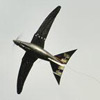 Robots inspired by moths, locusts, flies and swifts will take to the sky this week in an international competition for micro aerial vehicles in Agra, India. Teams will vie for the title — as well as up to US$600,000 in funding — for their tiny flying machines. The mission calls for squads of aerial and ground robots to reconnoitre for human ‘commandos’ tasked with reaching ‘hostages’ in a building one kilometre from the launch point. The robots will need to detect and disarm simulated chemical mines in an urban environment, and guide the commandos past guard teams to the hostages — all within 40 minutes.
Robots inspired by moths, locusts, flies and swifts will take to the sky this week in an international competition for micro aerial vehicles in Agra, India. Teams will vie for the title — as well as up to US$600,000 in funding — for their tiny flying machines. The mission calls for squads of aerial and ground robots to reconnoitre for human ‘commandos’ tasked with reaching ‘hostages’ in a building one kilometre from the launch point. The robots will need to detect and disarm simulated chemical mines in an urban environment, and guide the commandos past guard teams to the hostages — all within 40 minutes.
The robots will use a mixture of wireless communication with a ground-control team, and autonomous navigation.
“It’s a tough competition,” says entrant Hemendra Arya, an engineer at the India Institute of Technology in
Mumbai. “It really gives a challenge for the designer.”
Micro aerial vehicles (MAVs) are hard to detect, maneuverable, portable, and more energy-efficient than larger aircraft. The United States is currently using first-generation MAVs the size of a rucksack to warn convoys about roadside bombs in Iraq.
Larger unmanned aerial vehicles such as the Predator have been used for years to spot and attack enemies, but they need an airfield. The effort to build smaller craft got a boost when the US Defense Advanced Research Projects Agency (DARPA) began sponsoring competitions in late 1996. The US Department of Defense is co-sponsoring the Indian competition.
Fly like a bird
Competitions entrants must be smaller than 30 centimetres. Some teams shrink conventional unmanned
aircraft, but these craft are vulnerable to turbulence. Designs based on insect and bird wings seem to be more robust.
One entrant, RoboSwift, built by a Dutch team, draws on wind-tunnel studies of swift wings . These showed that swifts optimize their flight by sweeping their wings back for fast turns and extending them for gliding. To copy this, the Delft team made plastic ‘feathers’ that pivot and overlap to change the robot’s wing sweep and surface area.
RoboSwift had its first public test flight last Monday in the Netherlands. The craft failed on its first attempted launch into 50-kilometre-per-hour winds, but got airborne after some minor repairs.
RoboSwift is intended to be as birdlike as possible, says team adviser David Lentink, a zoologist at Wageningen University. It could even conceivably allow biologists to observe swifts, which almost never land, in flight. RoboSwift also doesn’t have landing gear, Lentink quips.
But RoboSwift isn’t quite up to scratch yet. After a five-minute flight, successfully morphing its wings, it then crashed into a tree. The Dutch team won the ‘most exotic’ category in the 2005 competition with its insect-inspired Delfly.
Natural inspiration
A team led by Paul Verschure, a computational neuroscientist at Pompeu Fabra University in Barcelona, Spain, is adding biologically inspired sensory systems to an off-the-shelf quad-rotor helicopter and two custom-built ground vehicles.
The ground robots will sniff out mines using a moth-like ‘nose’, and all the robots will avoid collisions and stay on course using software inspired by fly and locust flight2 (#B2) . Data from the robots will be combined with satellite imagery to give a human controller a three-dimensional picture of mines, obstacles and adversaries, projected onto a head-mounted screen. The flood of information will be filtered by software using similar computing methods to those used by the human brain to make sense of the avalanche of sensory data it receives every second.
Twelve teams are registered for the event. Two of last year’s winners, German-based Martin Mueller Engineering, and a team from the French National School of Civil Aviation in Toulouse, are also due to return, with more conventional models.
And this year, the robots face a new challenger: human adversaries, who will add an extra complicating factor to the simple search-and-rescue mission of previous competitions.
Watch a video on YouTube. (http://www.youtube.com/watch?v=PCB4g4xDZhI)